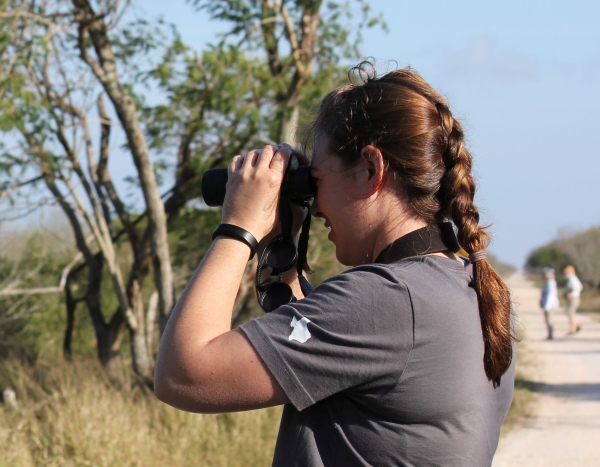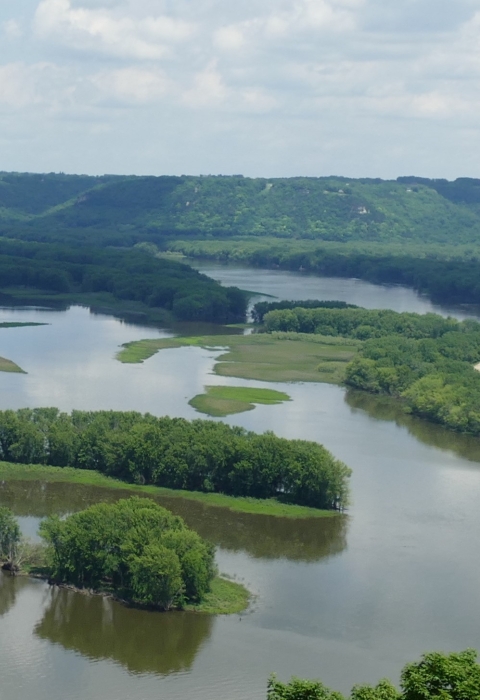
Located along the Mississippi Flyway, the Upper Mississippi River National Wildlife and Fish Refuge is one of the best places around to see residential and migratory birds throughout the seasons! Over 290 species of birds migrate through the refuge across its 240,000 acre stretch, utilizing the bottomland forest, marshland, river, and prairie ecosystems on their journeys. Whether you're searching for songbirds, water birds, shorebirds or raptors, here are some recommendations for when and where to look for them!
Spring
In March, the emblematic cry of red-winged blackbirds announces spring's arrival as they return to the wetlands. Canada geese build nests on top of muskrat huts and other high viewpoints near the water. April and May offer the best glimpses of songbirds that stopover or nest in the floodplain forest and marshes on their way back north from the tropics. Stopping by a boat landing and scanning the tree tops, or taking a walk on a trail through the floodplain forest can be great places to view spring warblers. Some songbirds, like ruby-crowned kinglets, chestnut-sided warblers, black-and-white warblers, and Cape May warblers, are only here for a a short time, while others, like blue-gray gnatcatchers, prothonotary warblers, American redstarts, warbling vireos, scarlet tanagers, and great crested flycatchers nest here in spring into summer.
Watch for tree swallows, barn swallows, and cliff swallows diving over wetland waters. Listen for the chattering twitter of chimney swifts and common nighthawks in evening hours by the river. Migratory woodpeckers like yellow-bellied sapsuckers and northern flicker also return to the woods; see if you can find the characteristic lines of sap wells that yellow-bellied sapsuckers drill into the bark of trees and search for northern flicker along the ground as they look for their favorite food - ants! Killdeer, lesser yellowlegs, upland sandpiper and other shorebirds can be seen along river shorelines.
Summer
Grassland birds arrive in the summer months; look for summer migrants like dickcissel, eastern meadowlarks, eastern bluebirds and indigo buntings and listen for the calls of clay-colored sparrows, grasshopper sparrows, and savannah sparrows on the prairie. Song sparrows and common yellowthroats sing in wetland environments, and listen for the chuckling laughter-like call of sora rails in the marsh. Ducks nest in the summer months: wood ducks and hooded mergansers in the bottomland forest; blue-winged teal in marshy areas, and mallards in grasslands or tall plants along the islands in the river. Hundreds of great egrets, blue herons, and double-crested cormorants build busy-looking twig-filled nests in rookeries on the islands. Small families of sandhill cranes also raise young along the river and marshes. American white pelicans cluster in large pods on the water in late summer, getting ready for the migration ahead! Turkey vultures ride the air currents around the bluffs along the river. Osprey and peregrine falcons also occasionally spotted along the river.
Fall
The fall season is a phenomenal time to see ducks, American white pelicans, geese, swans, American coot and other waterbirds. About 40% of the waterfowl in North America migrate along the Mississippi Flyway and many stop on the refuge as they make their journey south. Dabbling ducks, who prefer shallower waters, arrive first to the backwaters. Mallards, green-winged teal, American wigeon, northern shoveler, and northern pintail can be seen in large groups in at overlooks along the river backwaters in mid-late September through late-October/early November. Diving ducks usually arrive a little later and form large rafts on the deeper, open water where they feed on the roots and tubers of aquatic plants. Canvasback ducks, ring-necked ducks, lesser scaup, goldeneye, bufflehead, and redheads are often seen together. Tundra swans begin to arrive from the arctic around late October/early November, with the peak of migration typically being the second or third weekend in November. However, warmer fall weather has delayed their arrival over the last few years. Usually the swans will stay until the Mississippi River backwaters freeze over, or until late November or early December if the water stays open.
The best places to view tundra swans are usually:
Weaver Bottoms near Weaver, Minnesota
Parking is available on a service road on the west side of Highway 61 at 116th Avenue (mile marker 45), about 1.75 miles southeast of the Highway 61/Highway 74 junction.
Shady Maple Overlook near Stoddard, Wisconsin
The Shady Maple Overlook is located off of Highway 35, about one mile south of Goose Island County Park and about three miles south of La Crosse, Wisconsin. There are several parking spots at this paved "pull off" style overlook along with interpretive signs and a spotting scope to help viewers enjoy the migration. There are no restroom facilities at this location.
Brownsville Overlook near Brownsville, Minnesota
The Brownsville Overlook is located off of Highway 26, about three miles south of Brownsville, Minnesota. This paved parking lot provides multiple parking spots and hosts a portable accessible restroom from mid-October to mid-November. Mounted spotting scopes are available for visitors to enjoy. This is a very popular spot and is less crowded during weekdays. If the parking lot is full, please do not park along the highway - try visiting the Highway 26 Overlook about a mile south of the Brownsville Overlook, or take a walk along the dike at the Reno Bottoms Canoe Trail Access about 3.5 miles south of the Brownsville Overlook, then return to see if there's space at the overlook.
The best place to see rafts of diving ducks is usually the Reno Bottoms Canoe Trail Access, off of Highway 26 about 6.5 miles south of Brownsville, Minnesota. Look for a brown-and-white canoe emblem on the west side of the road as you drive south on Hwy 26, then for a small paved driveway on the east side of the road soon after. Visitors may park at a small gravel parking lot, then cross over a set of railroad tracks to a dike that spans the Mississippi River. Bald eagles sit in the water, on fallen logs or in trees watching for easy meals. Large groups of both diving ducks and puddle ducks swim close to the dike and even larger rafts of diving ducks can be seen with a spotting scope as you look north towards the main channel of the Mississippi River. Coots, a quirky-looking diving marsh bird with black feathers and a bright white bill, can often be seen mixed in with the ducks.
Winter
With many hardwood forest trees losing their leaves in the fall, winter is great time to look for woodpeckers and other hardy residential birds in the forests and marshes. The cheerful call of black-capped chickadees perks up listeners on chilly winter days, and the squeaky calls of downy and hairy woodpeckers let winter walkers know they're not alone in the forest. Listen for great horned owls and barred owls calling in December through March. Watch for red-tailed hawks perched in trees near wetland areas and for kestrel and rough-legged hawks near grassland areas. Golden eagles are infrequent, but not rare, visitors along the bluffs in January and February.
March also gifts birdwatchers with an unusual sight - as the water begins to open again on the Mississippi River, look for congregations of bald eagles siting in trees or on ice shelves along the water as they search for fish! Over 300 pairs of bald eagles nest on the refuge year round, but the late winter also brings migratory bald eagles who are slowly making their way farther north back to their nesting grounds. The best places to see bald eagles are around the Lock and Dams on the Mississippi River, where the churning water stays open most of the year.
